Comprehensive Identification of Migrating Compounds from Plastic Food Packaging Materials Using LC–HRAMS
Special Issues
This study assesses whether two commonly used plastic packaging materials are safe for use using liquid chromatography (LC) with high-resolution acccurate mass spectrometry (HRAMS) and data‑independent acquisition (DIA).
In order to ensure the continued use of plastic packaging in food, the packaging used must be safe for contact with food products, and not cause contact contamination. Of rising concern is the role of non-intentionally added substances (NIAS). Therefore, this study assesses whether two commonly used plastic packaging materials, polyethylene and low-density polyethylene plus nylon, are safe for use. Their potential migrants are analyzed using data-independent acquisition (DIA) and liquid chromatography (LC) coupled with high-resolution accurate mass spectrometry (HRAMS). Using automatic detection capabilities and filtering procedures, MS and tandem mass spectrometry (MS/MS) data were processed to find chemical formulae and structures and toxicity information for the most abundant analytes in a given sample. Through this method, 26 migrating compounds, mainly cyclic oligomers, were identified. Using the toxicity rules set out by Cramer, 19 of these 26 compounds were identified as having moderate or high toxicity.
Food packaging is a major market segment in the global food industry, often compared in size to that of the pharmaceutical industry (1). Over one third of all food packaging comprises materials made from plastic (1,2), which over the past several decades has extended to different plastic materials, copolymers, and additional ingredients.
Packaging itself is essential to our modern society. As our food supply chain has grown to become more global, plastic packaging has been instrumental in ensuring that the food reaching consumers is safe to eat. Packaging helps to preserve food by protecting it from light, humidity, oxygen, foreign compounds, mechanical influences, and microbial contamination, all of which help to improve shelf life (1). Two polymers used frequently in food packaging include polypropylene and polyethylene, with the latter being used in various forms including low-density polyethylene (LDPE), linear low-density polyethylene (LLDPE), and high-density polyethylene (HDPE) (3).
However, while food packaging protects from external contaminant introduction, there is increasing concern about the potential of chemical contamination from the plastic packaging itself. In fact, food contact migration is reported as one of the largest sources of food contamination, and is approximately 100–1000 times higher than that caused by pesticide residues (3,4). This migration can occur from multiple sources, including from contact with the internal face of the packaging, from diffusion and partition processes within multi-layered plastics, or even from adhesives.
The potential health implications that plastic contamination poses to the consumer have resulted in the control and supervision of plastic materials in multiple countries. For instance, the European Union has imposed Regulation EU 10/2011, which has established specific rules for what plastic materials can be applied safely to food packaging, and lists specific compounds that are authorized for use in plastic formulations and manufacturing (5). But, this regulation does not take into account unintentional substances, often referred to as non-intentionally added substances (NIAS), meaning they frequently do not appear in lists of permitted ingredients. NIAS may be introduced through a variety of processes: a result of interaction between ingredients, degradation of material components, or from impurities within the raw material (6). As a result, the migration of non-authorized substances must not exceed a level of 0.01 mg/kg of food or simulant.
To meet these strict criteria, highly sensitive and advanced analytical instruments and techniques are needed to test samples for the presence of NIAS. For nonvolatile chemicals in particular, liquid chromatography coupled to highâresolution accurate mass spectrometry (LC–HRAMS) has a proven history identifying nontarget compounds (7). In addition, nontargeted screening approaches assist in identifying potentially unknown contaminants compared to other acquisition methods. This technology has already been successfully applied to proteomics and metabolomics (8), as well as clinical and forensic toxicology (9).
The present study investigates the migration of compounds from two different multilayer plastic packaging materials commonly used in fruit puree and juices. Using an LC–QTOF instrument, coupled with data-independent acquisition, nontargeted peaks were identified and concentrations were compared against those dictated by EU regulation. Following the successful identification of molecular formulae and structures, the toxicity of these structures was assessed to determine the potential harm such NIAS pose to consumers.
Experimental
Method and Apparatus: Two commercially available multilayer plastic materials, used for the packaging of purees and juices from fruits and vegetables, were purchased over the internet for testing. The two multilayered materials used were: a polyethylene based material, and an LDPE plus nylon material.
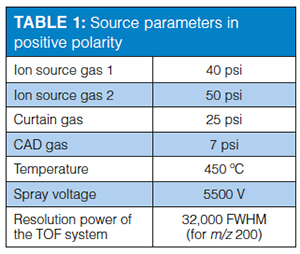
The migration test was performed according to the procedures established by EU Regulation 10/2011. The standardized test conditions, which simulate the long-term storage of food at or below room temperature, involve subjecting the material to 10 days of contact time with a contact temperature of 40 °C. Migration tests were performed using 1 dm3 surface area. This surface area was chosen as the regulation has previously established that materials can now be manufactured in such a way that the material is not releasing more than 10 mg per 1 dm3 of the plastic material.
Two simulants were used to measure the impact of material contact: simulant B, which consists of a solution of 3% acetic acid in water (w/v), and simulant C, which is a solution of 20% ethanol in water (v/v). For each material, 10 × 10 cm of plastic material was added to a 50 mL PTFE tube with 35 mL of the relevant simulant, in which carbendazim-d3 and malathion-d10 were added to the simulants as internal standards for quality control purposes. Three replicates and one control were performed. Each tube was placed in an incubator for 10 days at 40 °C. Afterwards, one aliquot of each sample was directly injected and analyzed by LC–HRAMS along with a calibration curve of ε-caprolactam.

The liquid chromatography separation was carried out using an Exion LC (Sciex). Mobile phase A was made up from 98% water and 2% methanol, and mobile phase B was made up from 98% methanol and 2% water. Both phases contained 5 mM of ammonium formate and 0.1% formic acid. Separation was carried out using a 100 mm × 2.1 mm, 1.8-µm Zorbax Eclipse Plus C8 column (Agilent). The column was thermostatted at 35 ºC. The mobile phase gradient started from 80% of mobile phase A, which was maintained for 2 min. From 2 to 15 min, the amount of mobile phase B increased linearly to 100%, which was then maintained for 2 min. The mobile phase was then changed to 80% A, maintained for 3 min for re-equilibration, leading to a total running time of 20 min. An X500R (Sciex) mass spectrometer equipped with Turbo V Source with a Twin Sprayer probe was used for acquisition. The data-independent acquisition tool SWATH Acquisition was used to analyze the data. A mixture containing 10 compounds with masses in the range of 132.9049–2034.6255 g/mol was used for calibration. Sciex OS 1.3 was used for qualitative and quantitative analysis. The source parameters for the mass spectrometer are reported in Tables 1–3.
Control samples were run in similar conditions, which are left to stand for 10 days at 40 ºC in the PTFE tube. Control samples were then compared with the three samples and used to filter out chemical peaks where the difference in intensity of the peaks was deemed to be negligible.
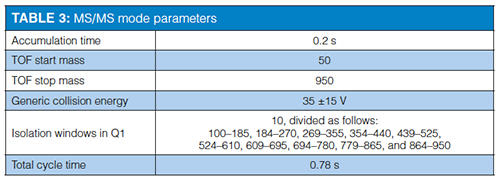
Results and Discussion
Identifying Migrant Compounds: A data-independent nontargeted acquisition mode was used to analyze the analytes. This approach segments the full scanned mass range into smaller segments for simpler MS/MS analysis, reducing the complexity of the fragmentation spectra. This allows for a retrospective analysis of the data, while ensuring that overlapping analyte peaks are not missed. This analysis proved vital in this study, owing to the complex overlap of spectra.
Using the strategy outlined in the experimental section, a total of 3149 spectral features were identified in the polyethylene-based material. Using the filtering strategy, the number of elucidating ions decreased from 3149 to 57 (which is characteristic of polyethylene packaging material), which then further decreased to only 21 ions after focusing on the most abundant compounds (those with a signal intensity above 1 × 106). However, to date, there is no library of NIAS substances to screen against the identified compounds, and none of the relevant ions were present in the commercial MS/MS spectral library used (Sciex). MS/MS libraries are constantly evolving but still only cover a limited number of analytes. For those compounds whose MS and MS/MS had the lowest associated error, probable structures were constructed using ChemSpider and then modelled in silico to compare fragmentation patterns against those observed. Owing to the numerous possible structures, chemical intuition and prior knowledge of the substance was essential to rule out many database structures.
From the two packaging materials, a total of 26 migrating compounds were identified from the screening method. Of these, 21 were assigned a plausible structure, which was later confirmed by fragmentation and bibliography agreement. A further three migrants were assigned a plausible structure based on fragmentation data, but these could not be confirmed. The final two structures could only be assigned molecular formulae, with not enough information collected to accurately assign structures. Spectra for the two materials using simulant C are reported in Figure 1. The summarized identity of those compounds identified is summarized in Table 4.

Most migrants were identified in both materials. The only compound listed in Regulation EU 10/2011 was caprolactam, a monomer of nylon (compound 2). It was found that caprolactam was present at 42 mg/kg in the polyethylene material and 9.33 mg/kg in the LDPE + nylon material. As European legislation permits concentrations of only 15 mg/kg, the migrant compound caprolactam is present at more than twofold higher concentrations in the polyethylene-based material (5). In addition, four cyclic oligomers of caprolactam were detected in both materials corresponding to the dimer, trimer, tetramer, and pentamer (compounds 4, 3, 5, and 6, respectively). This phenomenon is not surprising as oligomers up to the octamer have previously been identified in other migration studies (3,9,10).
Two other substances were identified: the plasticizer bis (2-methoxyethyl) adipate (compound 9) and diethyl 5-({[(2,4,5-trimethoxybenzoyl)oxy]acetyl}amino) isophthalate (compound 15). These were the results of the best matches based on identified chemical structures and fragmentation patterns.
All other compounds identified were classified as NIAS, with the majority being oligomers. The main migrants were oligomers from polyurethane adhesives. Cyclic ester oligomers were found to be made up of the monomers adipic acid (AA), phthalic acid (PA), diethylene glycol (DEG), monoethylene glycol (MEG), and neopentilglycol (NPG) in the combination 1:1 (AA-DEG, PA-DEG), 1:2 (PA-DEG-DEG), 2:2 (AA-MEG-AA-MEG, AA-DEG-AA-DEG, PA-DEG-PA-DEG), 1:1:2 (AA-MEG-AA-DEG, AA-DEG-PA-DEG) or 1:1:1:1 (PA-MEG-AA-DEG, PA-DEG-AA-NPG). However, once again most of the oligomers were not present in any library database consulted, and therefore identification was made based on a bibliographic search of their molecular masses. All oligomers were identified in the literature except for 3,6,9,12,15-Pentaoxabicyclo(15.3.1)henicosa-1(21),17,19-triene-2,16-dione, an ester whose appearance was attributed to the conceivable combination of monomers present in the materials.
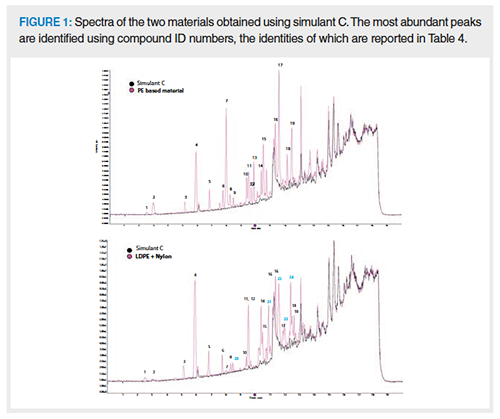
Only four substances were present only in the LDPE and nylon material. These are labelled as peaks 20–24 in Figure 1. Compounds 21, 22, and 24 had not been fully described in the literature, and there is currently no thorough hypothesis or explanation for the formation of these compounds in the present study. However, the peaks displayed similar characteristics to other oligomers already identified in the simulants. Peak 20 was identified as 1/6-dioxacyclodecane-7,12-dione and is attributed in the literature to the presence of polyurethane adhesives used to laminate packaging multilayer materials (11). Compound 23 was identified as 1,6,13,18-tetraoxacyclotetracosane-2,5,14,17-tetrone, also found in compostable adhesives (12).
The two peaks that were not identified are those labelled as 17 and 19 in Figure 1. It was only possible to assign the most probable chemical formula, identified as C19H33NO8 and C21H29NO8. Due to the number of potential structures in the databases (22 and 83 possibilities, respectively), it was not possible to identify a specific structure.
The chromatographs for the migration of compounds for simulants B and C are overall very similar. The overlapping chromatographs are shown in Figure 2. Only two peaks were identified as exclusively present in simulant B, labelled as compounds 25 and 26. Based on individual masses, these molecules were identified as the cyclic oligomers AA-DEG and AA-DEG-PA-DEG with a molecule of water.
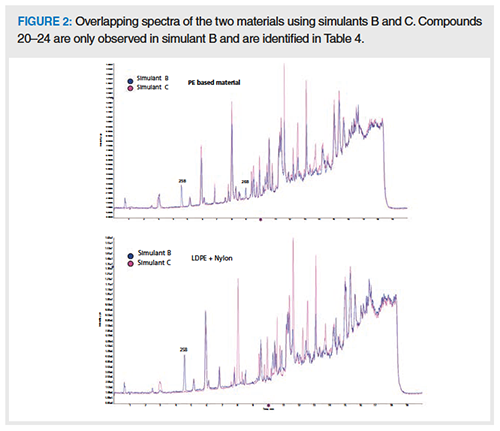
Packaging Material Toxicity
The toxicity of individual NIAS was then assessed to determine whether those compounds identified in the analysis are hazardous to public health. A bibliographic search for their toxicity found that the majority have not been registered in EU regulation. Thus, a theoretical assessment was performed using the Threshold of Toxicological Concern (TTC) approach (13–15). TTC is based on Cramer rules, which assigns the toxicity of compounds based on the molecular structure into the following categories: low (class I), moderate (class II), and high (class III). Cramer has also devised a maximum recommended intake value for each compound class of 1.8, 0.54, and 0.09 mg/person/day, respectively. Using these rules, only seven of the identified compounds were identified as low toxicity, with the results for all compounds summarized in Table 4.
Due to the potential toxicity these compounds pose, their presence in plastic materials intended for food could generate a risk for consumers. Given the peak intensity, and the high presence of caprolactam, the polyethylene-based material could pose a higher risk to consumers compared to the LDPE material.
Conclusions
This study sought to identify the potential migrating substances from food packaging contact. Two packaging materials were tested, polyethylene and low-density polyethylene plus nylon. A total of 26 substances were identified in this study, combining those identified in the LDPE and polyethylene materials: 21 have been assigned a confirmed structure, three have a tentative assigned structure, and the final two only have assigned molecular formulae. The majority of the compounds are considered by Cramer’s rules to be of moderate or high toxicity meaning their presence should be restricted to low concentrations. Only one compound identified is listed in the Regulation (EU) 10/2011: caprolactam, which was found to be above suggested concentrations in the sample of polyethylene tested. This work has shown the relevance and importance of evaluating NIAS in food contact materials to ensure consumer and food safety.
References
- J. Muncke, Sci. Total Environ.407, 4549 (2009). https://doi.org/10.1016/j.scitotenv.2009.05.006.
- B. Athenstädt, M. Fünfrocken, and T.C. Schmidt, Rapid Commun. Mass Spectrom. 26, 1810 (2012). https://doi.org/10.1002/rcm.6286.
- M. Hoppe, P. de Voogt, and R. Franz, Trends Food Sci. Technol.50, 118 (2016). https://doi.org/10.1016/j.tifs.2016.01.018.
- K. Grob, Food Control 46, 312 (2014). https://doi.org/10.1016/j.foodcont.2014.05.044.
- Commission Regulation (EU) No 10/2011 on plastic materials and articles intended to come into contact with food, European Commission, The Official Journal of the European Union, 2011, 15.1.2011. https://eur-lex.europa.eu/legal-content/EN/TXT/PDF/?uri=CELEX:32011R0010&from=EN
- C. Bignardi, A. Cavazza, C. Laganà, P. Salvadeo, and C. Corradini, Food Control71, 329 (2017). https://doi.org/10.1016/j.foodcont.2016.07.013.
- A.E. Lewandowska, K. Macur, P. Czaplewska, J. Liss, K. Lukaszuk, and S. Oldziej, J. Proteome Res.16, 3053 (2017). https://doi.org/10.1021/acs.jproteome.7b00366.
- M.P. Elmiger, M. Poetzsch, A.E. Steuer, and T. Kraemer, Anal. Bioanal. Chem.409, 6495 (2017). https://doi.org/10.1007/s00216-017-0594-1.
- D. Jenke, M. Poss, S. Sadain, J. Story, W. Smith, and D. Reiber, J. Appl. Polym. Sci.95, 1262 (2005). https://doi.org/10.1002/app.21341.
- S. Úbeda, M. Aznar, P. Vera, C. Nerín, L. Henríquez, L. Taborda, and C. Restrepo, Food Addit. and Contam., Part A34, 1784 (2017). https://doi.org/10.1080/19440049.2017.1346390.
- J.S. Félix, F. Isella, O. Bosetti, and C. Nerín, Anal. Bioanal. Chem.403, 2869 (2012). https://doi.org/10.1007/s00216-012-5965-z.
- E. Canellas, P. Vera, and C. Nerín, Anal. Bioanal. Chem. 407, 6781 (2015). https://doi.org/10.1007/s00216-015-8848-2.
- G.M. Cramer, R.A. Ford, and R.L. Hall, Food Cosmet. Toxicol.16, 255 (1976). https://doi.org/10.1016/S0015-6264(76)80522-6.
- I.C. Munro, A.G. Renwick, and B. Danielewska-Nikiel, Toxicol. Lett.180, 151 (2008). https://doi.org/10.1016/j.toxlet.2008.05.006.
- C. Nerin, P. Alfaro, M. Aznar, and C. Domeño, Anal. Chim. Acta775, 14 (2013). https://doi.org/10.1016/j.aca.2013.02.028.
Amadeo Fernández-Alba is a professor of analytical chemistry at the University of Almeria, Spain.
Ana Lozano is a postdoctoral researcher at the University of Almeria, Spain.
Maria José Gómez Ramos is a postdoctoral researcher at the University of Almeria, Spain.
Ashley Sage is the Senior Manager of Applied Markets Development at Sciex, in Warrington, UK.
Jianru Stahl-Zeng is the Applications Manager and Global Technical Leader for Food & Environmental at Sciex, in Darmstadt, Germany.
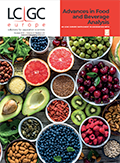
New Study Reviews Chromatography Methods for Flavonoid Analysis
April 21st 2025Flavonoids are widely used metabolites that carry out various functions in different industries, such as food and cosmetics. Detecting, separating, and quantifying them in fruit species can be a complicated process.
Analytical Challenges in Measuring Migration from Food Contact Materials
November 2nd 2015Food contact materials contain low molecular weight additives and processing aids which can migrate into foods leading to trace levels of contamination. Food safety is ensured through regulations, comprising compositional controls and migration limits, which present a significant analytical challenge to the food industry to ensure compliance and demonstrate due diligence. Of the various analytical approaches, LC-MS/MS has proved to be an essential tool in monitoring migration of target compounds into foods, and more sophisticated approaches such as LC-high resolution MS (Orbitrap) are being increasingly used for untargeted analysis to monitor non-intentionally added substances. This podcast will provide an overview to this area, illustrated with various applications showing current approaches being employed.

.png&w=3840&q=75)

.png&w=3840&q=75)



.png&w=3840&q=75)



.png&w=3840&q=75)





